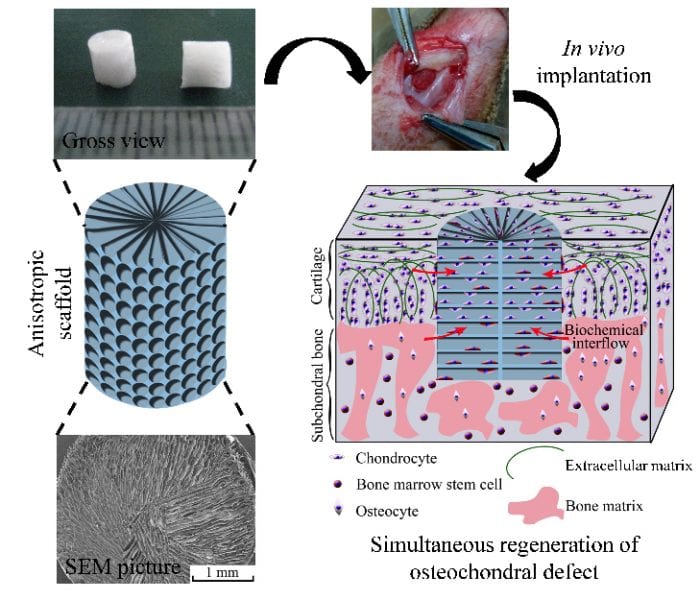After minor damage, human tissue has an incredible inherent self-healing capability through recruitment of stem cells and somatic cells. However, large-scale articular cartilage damage can hardly be regenerated automatically because of the lack of blood vessels and limited proliferation and migration of mature chondrocytes. Moreover, there exist different layers of cells and extracellular matrix in the cartilage, and an osteochondral defect always encompasses damage to the subchondral bone. An elaborately designed scaffold with fine structures is therefore required to serve as a support for the growth and proliferation of cells, and thereby formation of both cartilage and subchondral bone without the pre-seeding of any type of cells.
 Recently Prof. Changyou Gao and his co-workers at Zhejiang University, China, fabricated a methacrylated hyaluronic acid scaffold with oriented pores perpendicular to the axial direction by an unidirectional freeze-drying method. The structure was stabilized by photo-crosslinking, and was strengthened by infiltration of biodegradable PLGA. The oriented pores are beneficial to the migration and differentiation of cells, and may guide the spatial organization of cells and deposition of extracellular matrix. Furthermore, the oriented pores might increase the interflow between the native and neo tissues at different spatial levels, leading to a layered regeneration of different tissues. Transplantation of the cell-free scaffold in rabbit knees for 12 weeks in vivo regenerated simultaneously both cartilage and subchondral bone with a good integration with native tissues. Beside the in situ regeneration of cartilage, this type of oriented macroporous scaffolds may also find diverse applications in the inductive regeneration of different types of tissue, without the necessity of pre-loaded cells and bioactive molecules.
Recently Prof. Changyou Gao and his co-workers at Zhejiang University, China, fabricated a methacrylated hyaluronic acid scaffold with oriented pores perpendicular to the axial direction by an unidirectional freeze-drying method. The structure was stabilized by photo-crosslinking, and was strengthened by infiltration of biodegradable PLGA. The oriented pores are beneficial to the migration and differentiation of cells, and may guide the spatial organization of cells and deposition of extracellular matrix. Furthermore, the oriented pores might increase the interflow between the native and neo tissues at different spatial levels, leading to a layered regeneration of different tissues. Transplantation of the cell-free scaffold in rabbit knees for 12 weeks in vivo regenerated simultaneously both cartilage and subchondral bone with a good integration with native tissues. Beside the in situ regeneration of cartilage, this type of oriented macroporous scaffolds may also find diverse applications in the inductive regeneration of different types of tissue, without the necessity of pre-loaded cells and bioactive molecules.
















